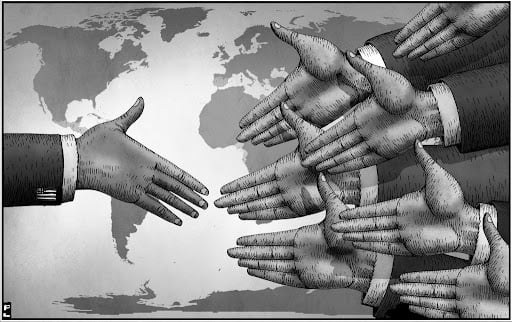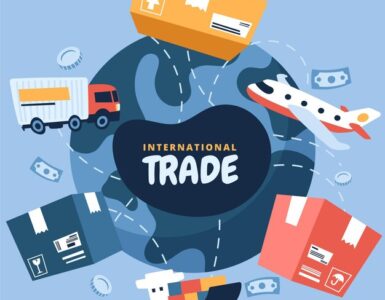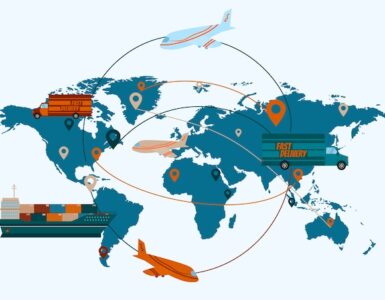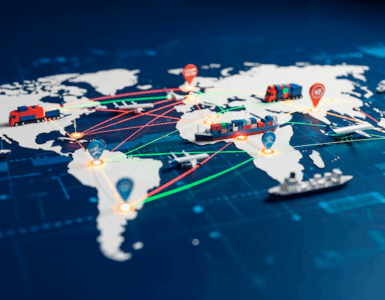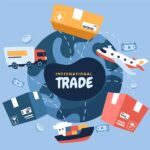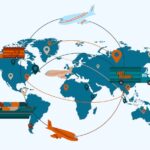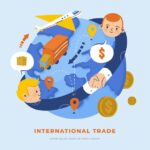| Recent decades have seen rapid growth of the world economy. This growth has been driven in part by the even faster rise in international trade. The growth in trade is in turn the result of both technological developments and concerted efforts to reduce trade barriers. Some developing countries have opened their own economies to take full advantage of the opportunities for economic development through trade, but many have not. Remaining trade barriers in industrial countries are concentrated in the agricultural products and labor-intensive manufactures in which developing countries have a comparative advantage. Further trade liberalization in these areas particularly, by both industrial and developing countries, would help the poorest escape from extreme poverty while also benefiting the industrial countries themselves.
I. International Trade and the World Economy Integration into the world economy has proven a powerful means for countries to promote economic growth, development, and poverty reduction. Over the past 20 years, the growth of world trade has averaged 6 percent per year, twice as fast as world output. But trade has been an engine of growth for much longer. Since 1947, when the General Agreement on Tariffs and Trade (GATT) was created, the world trading system has benefited from eight rounds of multilateral trade liberalization, as well as from unilateral and regional liberalization. Indeed, the last of these eight rounds (the so-called “Uruguay Round” completed in 1994) led to the establishment of the World Trade Organization to help administer the growing body of multilateral trade agreements. The resulting integration of the world economy has raised living standards around the world. Most developing countries have shared in this prosperity; in some, incomes have risen dramatically. As a group, developing countries have become much more important in world trade—they now account for one-third of world trade, up from about a quarter in the early 1970s. Many developing countries have substantially increased their exports of manufactures and services relative to traditional commodity exports: manufactures have risen to 80 percent of developing country exports. Moreover, trade between developing countries has grown rapidly, with 40 percent of their exports now going to other developing countries. However, the progress of integration has been uneven in recent decades. Progress has been very impressive for a number of developing countries in Asia and, to a lesser extent, in Latin America. These countries have become successful because they chose to participate in global trade, helping them to attract the bulk of foreign direct investment in developing countries. This is true of China and India since they embraced trade liberalization and other market-oriented reforms, and also of higher-income countries in Asia—like Korea and Singapore—that were themselves poor up to the 1970s. But progress has been less rapid for many other countries, particularly in Africa and the Middle East. The poorest countries have seen their share of world trade decline substantially, and without lowering their own barriers to trade, they risk further marginalization. About 75 developing and transition economies, including virtually all of the least developed countries, fit this description. In contrast to the successful integrators, they depend disproportionately on production and exports of traditional commodities. The reasons for their marginalization are complex, including deep-seated structural problems, weak policy frameworks and institutions, and protection at home and abroad. II. The Benefits of Trade Liberalization Policies that make an economy open to trade and investment with the rest of the world are needed for sustained economic growth. The evidence on this is clear. No country in recent decades has achieved economic success, in terms of substantial increases in living standards for its people, without being open to the rest of the world. In contrast, trade opening (along with opening to foreign direct investment) has been an important element in the economic success of East Asia, where the average import tariff has fallen from 30 percent to 10 percent over the past 20 years. Opening up their economies to the global economy has been essential in enabling many developing countries to develop competitive advantages in the manufacture of certain products. In these countries, defined by the World Bank as the “new globalizers,” the number of people in absolute poverty declined by over 120 million (14 percent) between 1993 and 1998.1 There is considerable evidence that more outward-oriented countries tend consistently to grow faster than ones that are inward-looking.2 Indeed, one finding is that the benefits of trade liberalization can exceed the costs by more than a factor of 10.3 Countries that have opened their economies in recent years, including India, Vietnam, and Uganda, have experienced faster growth and more poverty reduction.4 On average, those developing countries that lowered tariffs sharply in the 1980s grew more quickly in the 1990s than those that did not.5 Freeing trade frequently benefits the poor especially. Developing countries can ill-afford the large implicit subsidies, often channeled to narrow privileged interests, that trade protection provides. Moreover, the increased growth that results from freer trade itself tends to increase the incomes of the poor in roughly the same proportion as those of the population as a whole.6 New jobs are created for unskilled workers, raising them into the middle class. Overall, inequality among countries has been on the decline since 1990, reflecting more rapid economic growth in developing countries, in part the result of trade liberalization.7 The potential gains from eliminating remaining trade barriers are considerable. Estimates of the gains from eliminating all barriers to merchandise trade range from US$250 billion to US$680 billion per year. About two-thirds of these gains would accrue to industrial countries. But the amount accruing to developing countries would still be more than twice the level of aid they currently receive. Moreover, developing countries would gain more from global trade liberalization as a percentage of their GDP than industrial countries, because their economies are more highly protected and because they face higher barriers. Although there are benefits from improved access to other countries’ markets, countries benefit most from liberalizing their own markets. The main benefits for industrial countries would come from the liberalization of their agricultural markets. Developing countries would gain about equally from liberalization of manufacturing and agriculture. The group of low-income countries, however, would gain most from agricultural liberalization in industrial countries because of the greater relative importance of agriculture in their economies. III. The Need for Further Liberalization of International Trade These considerations point to the need to liberalize trade further. Although protection has declined substantially over the past three decades, it remains significant in both industrial and developing countries, particularly in areas such as agriculture products or labor-intensive manufactures and services (e.g., construction) where developing countries have comparative advantage. Industrial countries maintain high protection in agriculture through an array of very high tariffs, including tariff peaks (tariffs above 15 percent), tariff escalation (tariffs that increase with the level of processing), and restrictive tariff quotas (limits on the amount that can be imported at a lower tariff rate). Average tariff protection in agriculture is about nine times higher than in manufacturing. In addition, agricultural subsidies in industrial countries, which are equivalent to 2/3 of Africa’s total GDP, undermine developing countries’ agricultural sectors and exports by depressing world prices and pre-empting markets. For example, the European Commission is spending 2.7 billion euro per year making sugar profitable for European farmers at the same time that it is shutting out low-cost imports of tropical sugar. In industrial countries, protection of manufacturing is generally low, but it remains high on many labor-intensive products produced by developing countries. For example, the United States, which has an average import tariff of only 5 percent, has tariff peaks on almost 300 individual products. These are largely on textiles and clothing, which account for 90 percent of the $1 billion annually in U.S. imports from the poorest countries—a figure that is held down by import quotas as well as tariffs. Other labor-intensive manufactures are also disproportionately subject to tariff peaks and tariff escalation, which inhibit the diversification of exports toward higher value-added products. Many developing countries themselves have high tariffs. On average, their tariffs on the industrial products they import are three to four times as high as those of industrial countries, and they exhibit the same characteristics of tariff peaks and escalation. Tariffs on agriculture are even higher (18 percent) than those on industrial products.8 Nontraditional measures to impede trade are harder to quantify and assess, but they are becoming more significant as traditional tariff protection and such barriers as import quotas decline. Antidumping measures are on the rise in both industrial and developing countries, but are faced disproportionately by developing countries. Regulations requiring imports to conform to technical and sanitary standards comprise another important hurdle. They impose costs on exporters that can exceed the benefits to consumers. European Union regulations on aflotoxins, for example, are costing Africa $1.3 billion in exports of cereals, dried fruits, and nuts per European life saved.9 Is this an appropriate balance of costs and benefits? For a variety of reasons, preferential access schemes for poorer countries have not proven very effective at increasing market access for these countries. Such schemes often exclude, or provide less generous benefits for, the highly protected products of most interest to exporters in the poorest countries. They are often complex, nontransparent, and subject to various exemptions and conditions (including noneconomic ones) that limit benefits or terminate them once significant market access is achieved. Further liberalization—by both industrial and developing countries—will be needed to realize trade’s potential as a driving force for economic growth and development. Greater efforts by industrial countries, and the international community more broadly, are called for to remove the trade barriers facing developing countries, particularly the poorest countries. Although quotas under the so-called Multifiber Agreement are due to be phased out by 2005, speedier liberalization of textiles and clothing and of agriculture is particularly important. Similarly, the elimination of tariff peaks and escalation in agriculture and manufacturing also needs to be pursued. In turn, developing countries would strengthen their own economies (and their trading partners’) if they made a sustained effort to reduce their own trade barriers further. Enhanced market access for the poorest developing countries would provide them with the means to harness trade for development and poverty reduction. Offering the poorest countries duty- and quota-free access to world markets would greatly benefit these countries at little cost to the rest of the world. The recent market-opening initiatives of the EU and some other countries are important steps in this regard.10 To be completely effective, such access should be made permanent, extended to all goods, and accompanied by simple, transparent rules of origin. This would give the poorest countries the confidence to persist with difficult domestic reforms and ensure effective use of debt relief and aid flows. IV. Reaping the Benefits The failure to start a new round of multilateral trade negotiations at the WTO conference in Seattle in 1999 was a setback for the international trading system. Such broad-based multilateral negotiations are particularly important because they provide an opportunity for countries to gain visible benefits for their exporters from market opening by others. This prospect provides an added incentive for countries to open their own markets, and to overcome opposition from the entrenched interests benefiting from protection. In this way, the packages of trade liberalization measures that result for these negotiations are assured of benefiting all of the participating countries. A new round of negotiations would raise global growth prospects and strengthen the international trading system. The IMF considers a successful trade round to be an important step toward meeting the goal of making globalization work for the benefit of all. [“source=imf”] |

